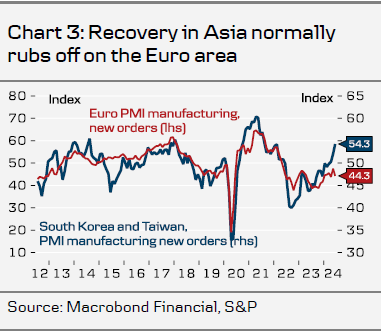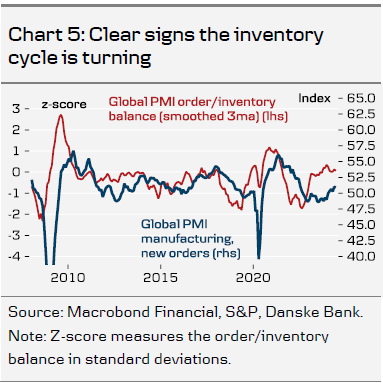-
After recovering in early 2024, US and euro PMIs have sputtered lately. Is the manufacturing recovery failing - or just taking a pause?
-
Based on our checklist we believe PMIs should start rising again soon. Asian PMI's have continued to rise, financial conditions have eased, the inventory cycle is still supportive and metal prices have trended higher. These factors normally point to a global manufacturing recovery covering all regions.
-
However, we continue to see an only mild recovery with a peak during the second half of 2024. It is expected to result in moderate goods inflation but not a new surge.
-
As the manufacturing sector is only a small part of the economies, a gradual recovery should not get in the way of central bank easing.
Back in February we argued that the global manufacturing cycle was turning (see Research Global: manufacturing cycle has turned – more to come, 7 February 2024) and we did indeed see signs of that going into the spring months. In April we argued for continued, albeit mild, manufacturing recovery in Research Global – Manufacturing recovery to continue into the summer, 15 April 2024. We have indeed continued to see global PMI manufacturing move higher but this has been driven by markets outside the US and Euro area In recent months manufacturing PMIs in these regions as well as the US ISM manufacturing index have fallen back and cast doubt over the manufacturing recovery. However, looking through our check list for manufacturing activity, we believe the recent weakness is more a pause than a new prolonged set-back. Below we go through the list one by one:
1. Asia PMI: Asia is generally the manufacturing hub of the world with economies like South Korea and Taiwan being key manufacturers of key components that go into manufacturing, not least microchips. The activity signals in these economies tend to give a short lead on manufacturing in Europe (chart 3) as well as the US. PMIs have continued higher in both South Korea and Taiwan in Q2 (chart 4) and the same has been the case in China, another key manufacturing hub. The AI boom and demand for advanced microchips may explain some of the increase in Taiwan and South Korea but that argument does not hold for China suggesting there is more to it than AI chips demand.
2. Inventory signals: Order-inventory ratios in the PMI statistics tend to provide a short lead on the overall cycle as well. While the ratios across countries have tended to flatline lately, they still indicate there is more ‘catching up’ to do in the actual PMIs (chart 5). The flatlining of the ratio does suggests, though, that the recovery will be mild and peak during the second half of the year.
This publication has been prepared by Danske Bank for information purposes only. It is not an offer or solicitation of any offer to purchase or sell any financial instrument. Whilst reasonable care has been taken to ensure that its contents are not untrue or misleading, no representation is made as to its accuracy or completeness and no liability is accepted for any loss arising from reliance on it. Danske Bank, its affiliates or staff, may perform services for, solicit business from, hold long or short positions in, or otherwise be interested in the investments (including derivatives), of any issuer mentioned herein. Danske Bank's research analysts are not permitted to invest in securities under coverage in their research sector.
This publication is not intended for private customers in the UK or any person in the US. Danske Bank A/S is regulated by the FSA for the conduct of designated investment business in the UK and is a member of the London Stock Exchange.
Copyright () Danske Bank A/S. All rights reserved. This publication is protected by copyright and may not be reproduced in whole or in part without permission.
Recommended Content
Editors’ Picks
EUR/USD drops to daily lows and challenges 1.0900 post-Lagarde

EUR/USD maintains its bearish bias and declines toward 1.0900 after the ECB left no room for surprises at its event, holding key rates unchanged. Meanwhile, President Lagarde said inflation in the region is expected to hit the 2% goal in H2 2025.
GBP/USD remains on the defensive in the sub-1.3000 region

GBP/USD stays on the back foot and trades in negative territory below 1.3000 in the American session on Thursday. The US Dollar benefits from the souring market mood and makes it difficult for the pair to build on its weekly gains.
Gold clings to modest daily gains above $2,460

Gold holds steady above $2,460 on Thursday after posting small losses on Wednesday. The rebound seen in the US Dollar amid risk aversion and the US Treasury bond yields' resilience, however, limits XAU/USD's upside in the American session.
Billionaire Mark Cuban highlights Silicon Valley's increasing support for former President Trump as a “Bitcoin Play”

Bitcoin (BTC) faces resistance and stalls at around the $65,000 mark on Thursday, while on-chain data indicate a rise in holdings among short-term investors, coupled with a slight increase in inflows at US spot Bitcoin ETFs.
What the US election could mean for deficits, debt and the yield curve

Government borrowing and the national debt are barely getting a mention in the US election campaign, yet a failure to change trajectory risks further debt downgrades, more market volatility and higher borrowing costs.


